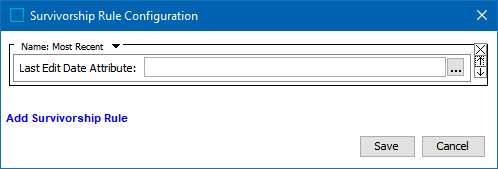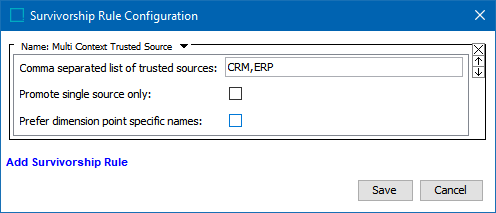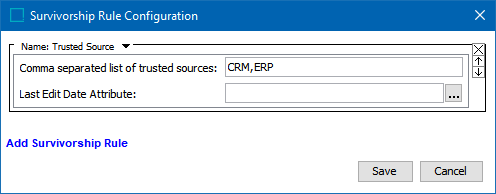On a matching algorithm, the following rules are available for promoting an object name to a golden record.
Name: Most Recent
Valid for strategies: merge or link
Specifies that 'Name' is taken from the source object with the most recent name. The analysis is performed in the single context / workspace selected in the algorithm, and that data is promoted across all contexts / qualifiers.

-
Last Edit Date Attribute - When no attribute is selected, the most recent date is the STEP object revision timestamp when the given element of the survivorship rule entered STEP.
Optionally, click the ellipsis button (
 ) and select the attribute that holds the value to be used as the last edit date when determining the most recent source record to promote to the golden record.
) and select the attribute that holds the value to be used as the last edit date when determining the most recent source record to promote to the golden record. -
When the selected attribute is valid for this object, timestamp is taken from the object.
-
When the selected attribute is not valid for the object, the value is taken from the given element of the survivorship rule, for example, a data container object or a reference object.
-
Name: Multi Context Trusted Source
Valid for strategies: link only
Specifies that the name promoted to the golden record is from the most trusted source and considers data that is dimension dependent. The analysis is performed for all contexts / qualifiers (a set of one or more dimension points, like country and language) in STEP.

-
Comma separated list of trusted sources - Enter a comma-separated list of the case-sensitive Source System ID for all trusted sources, starting with the most trusted source, then the next-most, and so on. Content is taken from the first trusted source with data. If content does not exist for any of the trusted sources, nothing is promoted to the golden record and the existing golden record value is cleaned. For information on the Source System ID Attribute setting, refer to the topic Configuring the Matching - Merge Golden Record Component Model.
-
Promote single source only - When checked, content from the most trusted source is used for all contexts / qualifiers, which prevents empty values in the golden record as long as one of the trusted sources has content. For example, when only the French language / France country context has a value, that value would be written into other contexts that are blank.
When not checked, each context / qualifier supplies its own content, including empty values when found.
-
Prefer dimension point specific names - When checked, only a local name is promoted.
When not checked, available inherited content is promoted if a local name does not exit.
Name: Trusted Source
Valid for strategies: merge or link
Specifies that 'name' is taken from the most trusted source. The analysis is performed in the single context / workspace selected in the algorithm, and that data is promoted across all contexts / qualifiers.

-
Comma separated list of trusted sources - Enter a comma-separated list of the case-sensitive Source System ID for all trusted sources, starting with the most trusted source, then the next-most, and so on. Content is taken from the first trusted source with data. If content does not exist for any of the trusted sources, nothing is promoted to the golden record and the existing golden record value is cleaned. For information on the Source System ID Attribute setting, refer to the topic Configuring the Matching - Merge Golden Record Component Model.
-
Last Edit Date Attribute - When no attribute is selected, the most recent date is the STEP object revision timestamp when the given element of the survivorship rule entered STEP.
Optionally, click the ellipsis button (
 ) and select the attribute that holds the value to be used as the last edit date when determining the most recent source record to promote to the golden record.
) and select the attribute that holds the value to be used as the last edit date when determining the most recent source record to promote to the golden record. -
When the selected attribute is valid for this object, timestamp is taken from the object.
-
When the selected attribute is not valid for the object, the value is taken from the given element of the survivorship rule, for example, a data container object or a reference object.
-